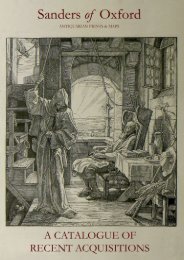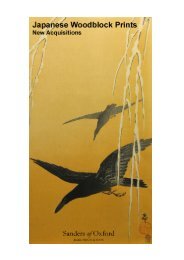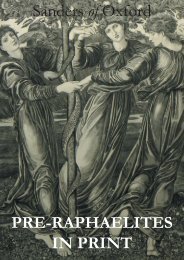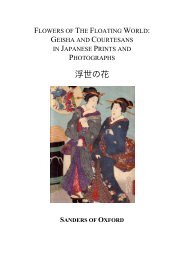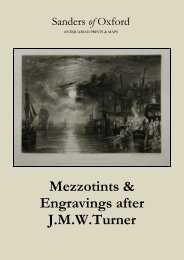«Heading» - International League of Antiquarian Booksellers
«Heading» - International League of Antiquarian Booksellers
«Heading» - International League of Antiquarian Booksellers
You also want an ePaper? Increase the reach of your titles
YUMPU automatically turns print PDFs into web optimized ePapers that Google loves.
Although various earlier plays had woven elements <strong>of</strong><br />
the tale into their narratives, the authors <strong>of</strong> the<br />
Kanadehon Chûshingura, by successfully relocating the<br />
drama within the belligerent struggles <strong>of</strong> the Kamakura<br />
period [1192-1333] (which included renaming the<br />
principal agitators) managed to both circumvent the<br />
unrelenting censorship <strong>of</strong> the portrayal <strong>of</strong> contemporary<br />
events imposed by the military government, and<br />
facilitate the transition <strong>of</strong> a scandalous and bloody<br />
vendetta into one <strong>of</strong> Japan's defining myths.<br />
Utagawa Kuniyoshi (c.1797 - April 14, 1861) was one<br />
<strong>of</strong> the last great masters <strong>of</strong> the Japanese ukiyo-e style <strong>of</strong><br />
woodblock prints and painting. He is associated with the<br />
Utagawa school. The range <strong>of</strong> Kuniyoshi's preferred<br />
subjects included many genres: landscapes, beautiful<br />
women, Kabuki actors, cats, and mythical animals. He<br />
is known for depictions <strong>of</strong> the battles <strong>of</strong> samurai and<br />
legendary heroes. His artwork was affected by Western<br />
influences in landscape painting and caricature.<br />
Condition: Some creases and wear to sheet, particularly<br />
the lower half. Repaired worm hole to the lower right <strong>of</strong><br />
sheet.<br />
[27389]<br />
£300<br />
Kabuki<br />
139. Oboshi Seizaemon Nobukiyo<br />
Woodblock print (nishiki-e)<br />
Utagawa Kuniyoshi (17977-1861)<br />
1847-48<br />
Oban tate-e single sheet [9.5 x 14 inches]<br />
mounted<br />
Signature: Ichiyusai Kuniyoshi ga<br />
Seal: Kiri<br />
Cens: Muramatsu - Yoshimura.<br />
Series: Seichu gishi den: Stories <strong>of</strong> the true loyalty <strong>of</strong><br />
the faithful samurai<br />
Publisher: Ebi-ya Rinnosuke<br />
Reference: Weinberg, Kuniyoshi: The Faithful Samurai<br />
(2000), I.32; Robinson, Kuniyoshi: The Warrior-Prints<br />
(1982), list S54.32<br />
One <strong>of</strong> Kuniyoshi's most lauded series, based on the<br />
Kanadehon Chushingura, popularly known as ‘The<br />
Revenge <strong>of</strong> the 47 Ronin’. Originally written in the late<br />
1740s for the Bunraku (puppet theatre) by Takeda<br />
Izumo, Namiki Senryû and Miyoshi Shôraku, the<br />
eleven-act Kanadehon Chûshingura (A Kana Primer for<br />
the Treasury <strong>of</strong> Loyal Retainers) became the most<br />
popular theatrical interpretation <strong>of</strong> an emotive and<br />
rapidly mythologized historical incident known<br />
variously as the Akô rôshi (The Masterless Samurai <strong>of</strong><br />
Akô), the Forty-seven Rônin, (Shijûshichirônin) and the<br />
Genroku akô jiken (The Affair at Akô in the Genroku<br />
Era). The incident in question took place in the 14th<br />
year <strong>of</strong> Genroku [1701], and involved the revenge <strong>of</strong> a<br />
group <strong>of</strong> loyal samurai against the daimyô (lord) who<br />
had malevolently insulted their master and subsequently<br />
caused his death.<br />
140. [Kabuki Actors]<br />
Woodblock print (nishiki-e)<br />
Kunichika Toyohara (1835-1900)<br />
c. 1870<br />
Ôban tate-e triptych [Each sheet 14 x 9 1/2 inches]<br />
mounted<br />
Signature: Toyohara Kunichika hitsu<br />
Seal: Toshidama<br />
One <strong>of</strong> the last <strong>of</strong> the great ukiyo-e masters, Kunichika<br />
was born Oshima Yasohachi in 1835, in the Kyobashi<br />
district <strong>of</strong> Edo (modern Tokyo). The area was home to<br />
merchants and artisans and comprised the heart <strong>of</strong> the<br />
Edo culture. In early childhood he assumed the surname<br />
"Arakawa" from his mother. At age 11, he was<br />
apprenticed to the Yamagata-e, a thread and yarn store<br />
in the Nihonbashi district, but already preferred<br />
sketching to learning the skills <strong>of</strong> the dry-goods trade.<br />
By 1846, when his elder brother opened a "raised<br />
picture" (oshie-e) shop, Yasohachi began to produce<br />
illustrations for him. He also designed actor portraits for<br />
various notable clients. In 1848, at age 13, he was<br />
accepted as an apprentice into the studio <strong>of</strong> Kunisada<br />
(Toyokuni III, 1786-1865).




